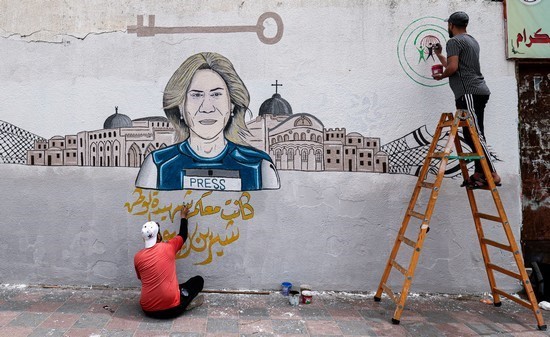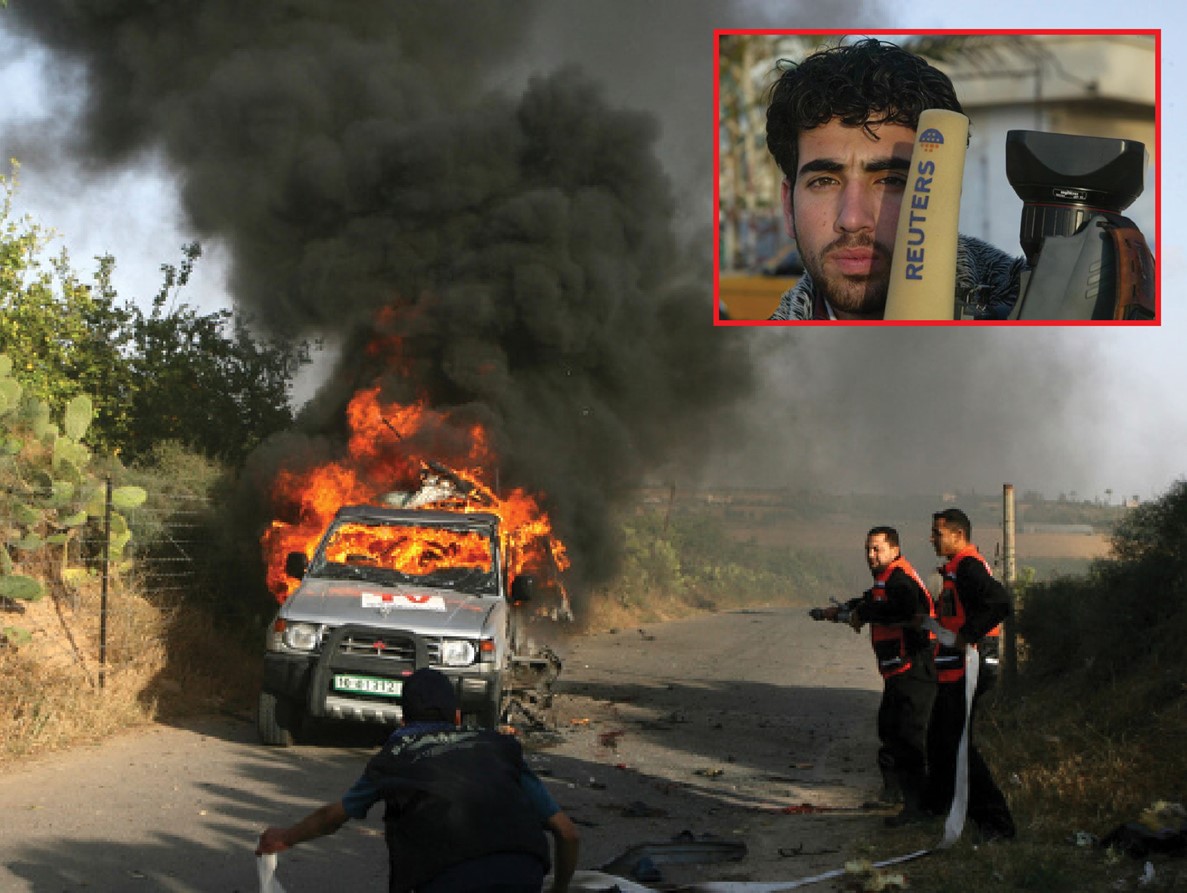Israel’s bloody history with field personnel
By Jude Taha, Jordan News
last updated: May 15,2022

The news of Shireen Abu Akleh’s death at the hands of Israeli occupation forces
in the West Bank town of Jenin as she was covering an Israel raid — while
clearly identified as press — caused uproar worldwide. Yet, for Israel, such
slaying is not new.اضافة اعلان
Since 2001, according to statistics by the Palestinian Journalism Syndicate, Israel has killed more than 55 Palestinian journalists. Reporters Without Borders recorded more than 144 journalists injured just in the last four years.
Soon after Abu Akleh’s killing, Israel’s tactics to avoid accountability were given free rein.

Palestinian artists paint a mural honoring slain veteran Al-Jazeera journalist Shireen Abu Akleh, in Khan Younis in the southern Gaza Strip, on May 14, 2022. (Photo: AFP)
Israel’s spin on the brutal shooting, which it blamed on Palestinian gunfire, was quickly debunked by Israeli human rights group B’Tselem. It then claimed that it will hold an “investigation”, a risible proposition when even the Israeli diaspora minister, Nachman Shai, said that “Israel’s credibility is not very high in such cases”.
Field workers, from journalists to medics, are protected under international conventions while on assignment, even in case of war. Yet, despite the growing number of deaths and injuries it causes, Israel continues to behave appallingly with impunity under the indifferent glance of the international community.
Here are the stories of five field personnel killed or severely injured by Israel.
Brian Avery
American human rights activist with the International Solidarity Committee (ISC) Brian Avery was shot in the face on April 5, 2003, in the West Bank city of Jenin by Israeli soldiers while going to investigate gunfire sounds outside the ISC headquarters.
Before the shooting, Avery was standing with his arms held up. Just like Abu Akleh, he was wearing an identifying vest — fluorescent, with a reflective white cross on the front and back. According to Human Rights Watch, the shooting was “unprovoked and did not occur in the context of any apparent hostilities”.
Avery became seriously disfigured. In an interview in 2004, he said that he had undergone several reconstructive surgeries, lost half of his upper jaw and part of his facial bone, had a fractured lower jaw, and has a disrupted nasal bone and eye structure.
Two years after the shooting, on February 28, 2005, Avery returned to Tel Aviv requesting a criminal investigation into his shooting. The Israeli Supreme Court called for the Israeli army to conduct an internal command inquiry.
The army later concluded that there was no evidence that Brian was hit by shots fired by Israeli soldiers. Avery filed an appeal, and in 2008 accepted a $150,000 settlement from Israel.
Shlomo Lecker, Avery’s Israeli lawyer, said that Avery settled due to the medical costs and skepticism regarding any satisfactory findings.

Undated photo of Yaser Murtaja.(Photo: Twitter)
Yaser Murtaja
At 30, Yaser Murtaja, a photojournalist from Gaza who had never left this coastal town, was killed in 2018 by an Israeli sniper, despite him wearing a bulletproof press vest.
Murtaja was covering the protests along the Gaza Strip’s border. He was known for his stories on residents of the Strip through documentaries and photos, and his hopes to one day travel and see the world beyond the city shores.
Murtaja, a father of one, captioned a photo, an aerial view of the Gaza coast with “My dream is for the day to come when I snap this image from the sky and not the ground. My name is Yaser, I am 30 years old, live in Gaza City, and I have never traveled before!”, just two weeks before he was killed.
He had co-founded a media production company in Gaza.
After his death, Israel stated that it does not target journalists, just as it said after killing Abu Akleh. Avigdor Liberman, Israeli minister of defence at the time, alleged that Murtaja was a member of Hamas’ military wing. However, no proof was produced, and Murtaja’s colleagues refuted the statement.
According to Al-Jazeera, six other journalists were wounded by the Israeli occupation during their coverage of the border protests alongside Murtaja.

Portrait graphic of 21-year-old nurse Razan Al-Najjar with a flower by the Palestinian Artist Taghi Al-Din. (Photo: Wikimedia Commons)
Razan Al-Najjar
According to her collogues, Razan Al-Najjar, a 21-year-old volunteer medic, took all precautions when going to treat wounded protestors on June 1, 2018.
However, despite wearing a white coat, Najjar was shot and killed by an Israeli sniper. In an investigation, Israeli human rights group B’Tselem found that she was shot deliberately. Najjar “was fatally shot by a member of the security forces who was aiming directly at her as she was standing about 25 meters away from the fence, despite the fact that she posed no danger to him or anyone else and was wearing a medical uniform”, the group said in a statement.
Najjar was attempting to rescue two men who had passed out due to heavy Israeli tear gas. Reports from her colleagues stated that her hands were held up, much like Avery’s, as “two soldiers got out of a military jeep and pointed their guns at us. They fired two bullets at us”, said Mahmoud Abd Al-Ati, a medic that was with Razan at the time.
A bullet hit Najjar, and after 30 minutes of resuscitation attempts, she was pronounced dead.
In an interview with the New York Times, a month before her death, she had said: “We have one goal — to save lives and evacuate people. … and to send a message to the world: Without weapons, we can do anything.”
Shortly after her death, Izzat Shatat, a volunteer ambulance worker, told the Associated Press that he and Najjar were planning to announce their engagement at the end of Ramadan.

Muath Amarneh. (Photo: Twitter)
Muath Amarneh
On November 15, 2019, Muath Amarneh, a freelancer from Al-Dheisheh refugee camp in the West Bank city of Bethlehem, was shot in his left eye by Israeli forces while covering protests near Hebron.
Amarneh was wearing a bulletproof press vest when he was shot, apparently with a rubber bullet. Photos of Amarneh after he was shot circulated on social media and prompted a solidarity campaign from activists.
Social media users, including teachers, students, and international youth organizations ranging from the US to Malaysia, joined the online movement by posting photos covering their eyes and using the hashtags #MuathEye, or #EyeOfTruth.
Amarneh lost his eye after the incident, his career endangered. The Anadolu Agency reported that doctors could not remove shrapnel from his head due to the high risk to his life.

A photo of Fadel Shanaa (top right corner) and his vehicle after being destroyed by Israeli shelling. (Photos: Maan Photos and Twitter)
Fadel Shanaa
Reuters cameraman Fadel Shanaa was killed by flechettes fired by an Israeli tank in April 2008 in Gaza. Shanaa was wearing a press flak jacket and was traveling in a car-marked TV.
The 23-year-old was about to film an Israeli tank dug in several hundred meters away. However, the last thing captured by Shanaa’s camera was a flash and smoke from the tank as it opened fire. The screen went blank, and the metal arrows exploded, ripping into his chest and legs, killing him instantly.
Fire destroyed the car shortly after. Eight young bystanders, aged 12 to 20, were also killed in the incident.
On August 13, 2008, it was reported that the Israeli military closed an investigation opened into Shanaa’s death without taking disciplinary action against the tank crew that killed him, according to the New York Times.
Reuters, demanded an independent investigation, stating that Israel “was in clear breach of its duty under international law to avoid harm to civilians”.
Thousands attended his funeral procession in Gaza.
Read more Region and World
Jordan News
Since 2001, according to statistics by the Palestinian Journalism Syndicate, Israel has killed more than 55 Palestinian journalists. Reporters Without Borders recorded more than 144 journalists injured just in the last four years.
Soon after Abu Akleh’s killing, Israel’s tactics to avoid accountability were given free rein.

Palestinian artists paint a mural honoring slain veteran Al-Jazeera journalist Shireen Abu Akleh, in Khan Younis in the southern Gaza Strip, on May 14, 2022. (Photo: AFP)
Israel’s spin on the brutal shooting, which it blamed on Palestinian gunfire, was quickly debunked by Israeli human rights group B’Tselem. It then claimed that it will hold an “investigation”, a risible proposition when even the Israeli diaspora minister, Nachman Shai, said that “Israel’s credibility is not very high in such cases”.
Field workers, from journalists to medics, are protected under international conventions while on assignment, even in case of war. Yet, despite the growing number of deaths and injuries it causes, Israel continues to behave appallingly with impunity under the indifferent glance of the international community.
Here are the stories of five field personnel killed or severely injured by Israel.
Brian Avery
American human rights activist with the International Solidarity Committee (ISC) Brian Avery was shot in the face on April 5, 2003, in the West Bank city of Jenin by Israeli soldiers while going to investigate gunfire sounds outside the ISC headquarters.
Before the shooting, Avery was standing with his arms held up. Just like Abu Akleh, he was wearing an identifying vest — fluorescent, with a reflective white cross on the front and back. According to Human Rights Watch, the shooting was “unprovoked and did not occur in the context of any apparent hostilities”.
Avery became seriously disfigured. In an interview in 2004, he said that he had undergone several reconstructive surgeries, lost half of his upper jaw and part of his facial bone, had a fractured lower jaw, and has a disrupted nasal bone and eye structure.
Two years after the shooting, on February 28, 2005, Avery returned to Tel Aviv requesting a criminal investigation into his shooting. The Israeli Supreme Court called for the Israeli army to conduct an internal command inquiry.
The army later concluded that there was no evidence that Brian was hit by shots fired by Israeli soldiers. Avery filed an appeal, and in 2008 accepted a $150,000 settlement from Israel.
Shlomo Lecker, Avery’s Israeli lawyer, said that Avery settled due to the medical costs and skepticism regarding any satisfactory findings.

Undated photo of Yaser Murtaja.(Photo: Twitter)
Yaser Murtaja
At 30, Yaser Murtaja, a photojournalist from Gaza who had never left this coastal town, was killed in 2018 by an Israeli sniper, despite him wearing a bulletproof press vest.
Murtaja was covering the protests along the Gaza Strip’s border. He was known for his stories on residents of the Strip through documentaries and photos, and his hopes to one day travel and see the world beyond the city shores.
Murtaja, a father of one, captioned a photo, an aerial view of the Gaza coast with “My dream is for the day to come when I snap this image from the sky and not the ground. My name is Yaser, I am 30 years old, live in Gaza City, and I have never traveled before!”, just two weeks before he was killed.
He had co-founded a media production company in Gaza.
After his death, Israel stated that it does not target journalists, just as it said after killing Abu Akleh. Avigdor Liberman, Israeli minister of defence at the time, alleged that Murtaja was a member of Hamas’ military wing. However, no proof was produced, and Murtaja’s colleagues refuted the statement.
According to Al-Jazeera, six other journalists were wounded by the Israeli occupation during their coverage of the border protests alongside Murtaja.

Portrait graphic of 21-year-old nurse Razan Al-Najjar with a flower by the Palestinian Artist Taghi Al-Din. (Photo: Wikimedia Commons)
Razan Al-Najjar
According to her collogues, Razan Al-Najjar, a 21-year-old volunteer medic, took all precautions when going to treat wounded protestors on June 1, 2018.
However, despite wearing a white coat, Najjar was shot and killed by an Israeli sniper. In an investigation, Israeli human rights group B’Tselem found that she was shot deliberately. Najjar “was fatally shot by a member of the security forces who was aiming directly at her as she was standing about 25 meters away from the fence, despite the fact that she posed no danger to him or anyone else and was wearing a medical uniform”, the group said in a statement.
Najjar was attempting to rescue two men who had passed out due to heavy Israeli tear gas. Reports from her colleagues stated that her hands were held up, much like Avery’s, as “two soldiers got out of a military jeep and pointed their guns at us. They fired two bullets at us”, said Mahmoud Abd Al-Ati, a medic that was with Razan at the time.
A bullet hit Najjar, and after 30 minutes of resuscitation attempts, she was pronounced dead.
In an interview with the New York Times, a month before her death, she had said: “We have one goal — to save lives and evacuate people. … and to send a message to the world: Without weapons, we can do anything.”
Shortly after her death, Izzat Shatat, a volunteer ambulance worker, told the Associated Press that he and Najjar were planning to announce their engagement at the end of Ramadan.

Muath Amarneh. (Photo: Twitter)
Muath Amarneh
On November 15, 2019, Muath Amarneh, a freelancer from Al-Dheisheh refugee camp in the West Bank city of Bethlehem, was shot in his left eye by Israeli forces while covering protests near Hebron.
Amarneh was wearing a bulletproof press vest when he was shot, apparently with a rubber bullet. Photos of Amarneh after he was shot circulated on social media and prompted a solidarity campaign from activists.
Social media users, including teachers, students, and international youth organizations ranging from the US to Malaysia, joined the online movement by posting photos covering their eyes and using the hashtags #MuathEye, or #EyeOfTruth.
Amarneh lost his eye after the incident, his career endangered. The Anadolu Agency reported that doctors could not remove shrapnel from his head due to the high risk to his life.

A photo of Fadel Shanaa (top right corner) and his vehicle after being destroyed by Israeli shelling. (Photos: Maan Photos and Twitter)
Fadel Shanaa
Reuters cameraman Fadel Shanaa was killed by flechettes fired by an Israeli tank in April 2008 in Gaza. Shanaa was wearing a press flak jacket and was traveling in a car-marked TV.
The 23-year-old was about to film an Israeli tank dug in several hundred meters away. However, the last thing captured by Shanaa’s camera was a flash and smoke from the tank as it opened fire. The screen went blank, and the metal arrows exploded, ripping into his chest and legs, killing him instantly.
Fire destroyed the car shortly after. Eight young bystanders, aged 12 to 20, were also killed in the incident.
On August 13, 2008, it was reported that the Israeli military closed an investigation opened into Shanaa’s death without taking disciplinary action against the tank crew that killed him, according to the New York Times.
Reuters, demanded an independent investigation, stating that Israel “was in clear breach of its duty under international law to avoid harm to civilians”.
Thousands attended his funeral procession in Gaza.
Read more Region and World
Jordan News


